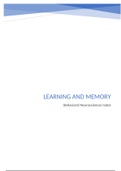LEARNING AND MEMORY
Behavioral Neurosciences notes
, WHAT IS LEARNING AND MEMORY?
Learning allows us to acquire new information and refers to the acts, process or
experience of gaining knowledge or skill. Memory is the process by which what is
learned persists over time. Memory is basically a long-term change in the nervous
system following learning.
Experiences are not ‘stored’ in the brain as memories; rather, they change the way
we perceive, perform, think, plan etc. Whenever you learn something, you gain the
knowledge or skill, then certain behavioral modifications especially through
experience occur = CNS changes -> results in formation of memory which further
can be stored and retrieved whenever you needed. Learning, memory and their
effects on behaviour are only possible through plasticity. The information-
processing model of memory provides an overall summary of the basic steps linking
learning to memory. In this model, learning produces changes in the nervous system
by encoding the new information to be learned. The encoding process includes
consolidation, which strengthens changes associated with the initial information
that is learned, helping to make a more permanent change to the nervous system
(i.e., a memory). After being consolidated, the memory is stored via these
persistent changes in the nervous system. Finally, retrieval is the process of
accessing and using the information stored in the neural changes that make up a
memory to engage in a behavior.
Memory
Again, memory is the process of encoding, storing and retrieving experiences and
knowledge. Some memories are the ones we are aware of and we can consciously
recall them -> known as Explicit Memories.
,Implicit Memories -> are ones that we cannot consciously access. This type of
memory uses past experiences to remember things without thinking about them.
Like using motor muscle to move lips when we speak or produce sound the way we
learned it.
What is a Forgetting Curve?
Also known as Ebbinghaus’ forgetting curve, shows how information is lost over
time when you don’t try to retain it. A typical graph shows that humans tend to
halve their memory of newly learned knowledge in a matter of days or weeks unless
they consciously review the learned material.
According to Ebbinghaus there are two key principles for learning:
1) Memories – they have different time spans (can be short vs long lived)
2) Repetition – life span memory increases
, Primary vs Secondary Memory
Primary memory = it can be referred to as short-term memory and it only lasts for
seconds and minutes – it is an extension of the present moment
Secondary memory = this can be referred to as long-term memory and it lasts
much longer, weeks – years, it can be consulted by reaching back into the past
According to F. C. Bartlett – remembering is not the re=excitation of innumerable
fixed, lifeless and fragmentary traces. It is an imaginative reconstruction or
construction = the idea behind this is that remembering is an active process – it is
not just pressing ‘play button’.
Types of Memories
There are several types of memories, some of which are forgotten very quickly
while others remain a lifetime. The types of memories are:






